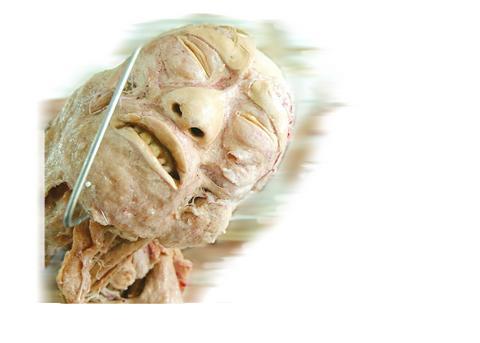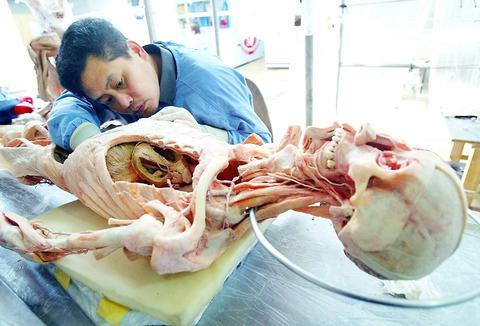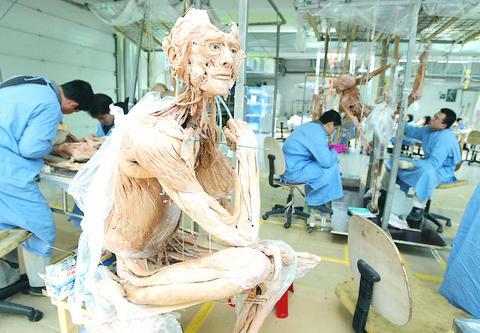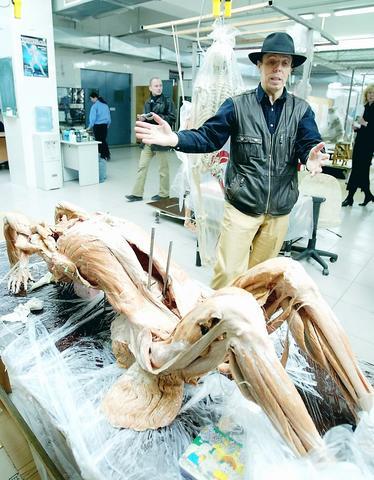Hidden in a maze of factories in the heart of this northeastern Chinese port city is the house Gunther von Hagens built -- and, for many, a place where nightmares are created.
Inside von Hagens' sprawling, well-guarded compound, behind a leaning metal fence pocked with holes, are more than 800 human beings -- 200 of his staffers and 645 dead bodies in steel cases from almost a dozen nations.

PHOTO: AP
The anatomist, whose exhibits of preserved human corpses have riled religious leaders in Europe and attracted the curious and the outraged across the world, set up shop here three years ago to process bodies for his shows.

PHOTO: AP
Last month, media reports from von Hagens' native Germany asserted that at least two of the corpses, both Chinese, had bullet holes in their skulls -- the method China uses for execution. It's a charge that von Hagens rejects vehemently, saying all his specimens were donated by people who signed releases.
``I absolutely prohibit and do not accept death penalty bodies,'' von Hagens, a tall, thin man in a fedora, said this week during a rare tour of his Dalian facility.

PHOTO: AP
But, he added, ``Many things can happen. ... I cannot exclude that [possibility].''

PHOTO: AP
Von Hagens launched his Body Worlds exhibits in 1997 and has shown them to nearly 14 million people from Japan and South Korea to Britain and Germany. Shows are running now in Frankfurt, Germany, and Singapore.
The displays feature healthy and diseased body parts as well as skinned, whole corpses in assorted poses -- a rider atop a horse, a pregnant woman reclining -- that show off the preservation technique von Hagens developed in 1977.
Dubbed ``plastination,'' the process replaces bodily fluids and fat with epoxy and silicone, making the bodies durable for exhibition and study.
Though authorities in Dalian have made no public allegations against the operation, it has drawn the attention of the Chinese media. ``Does the corpse factory have a trade secret?'' asked theBeijing Morning Post.
``Investigation into the secrets of Dalian's corpse processing plant,'' read another in theBeijing Evening News.
Li Renzhen, a Dalian taxi driver, said, ``I don't know what they are doing in there. But according to Chinese tradition, we should show respect for dead bodies.''
He shook his head.
``If they are used to make money, it's unthinkable.''
The German weekly Der Spiegel said in January that von Hagens ran a ``shabby business,'' buying cheap corpses -- including executed Chinese -- and marketing them for profit. A British newspaper, The Daily Telegraph, said German lawyers also were investigating whether von Hagens used executed Chinese
prisoners.
The allegations echoed charges from 2001, when von Hagens was accused of using a Russian prisoner's body. Von Hagens said that corpse was a German who donated his body.
Von Hagens said his staff searched their cache of bodies after the Der Spiegel article appeared and found seven with ``different kinds of head injuries.'' He said he planned to incinerate those to be certain execution victims are not used.
``There is no case opened against me,'' said von Hagens, 59. ``Nobody accuses me ... of doing anything criminal, anything against the law.''
However, prosecutors in Heidelberg, Germany, say they are pursuing allegations that von Hagens used bodies of Chinese prisoners to determine whether they have grounds to launch a full-scale investigation into possible charges of human rights violations for using corpses of people who had not given consent while still living.
``We are looking into it right now,'' said Elke O'Donoghue, spokeswoman for prosecutors in Heidelberg. She could not say how long the process would take.
Critics, including the Lutheran and Roman Catholic churches, have also denounced von Hagens' work as disrespectful to the dead. He says he simply helps people understand their bodies.
In Frankfurt, authorities have warned parents not to allow children younger than 14 to view the exhibit, which they said could ``shock and frighten.''
At a London show, a visitor took a hammer to one of the bodies -- a man holding a liver -- while another threw a blanket over the corpse of a pregnant woman, saying he could not bear to look at the fetus.
``It's a very emotional topic,'' acknowledged von Hagens, dubbed ``Dr. Frankenstein'' in November after performing Britain's first public autopsy in more than 170 years. Even in Dalian, one of his employees jokingly referred to him as ``Dr. Death.''
In one airy room, skinned corpses wrapped in white cloth and covered in plastic lay stretched out on tables, surrounded by ``dissectors'' -- many of them medical students. They hunched over the bodies, picking out fat and tissue with tweezers. In another area, bodies hung ``curing'' with gas, light or heat.
Each body requires up to 1,500 hours of work to prepare, von Hagens says. In their final plasticized state, the corpses are rubbery to the touch with a crystalline finish -- the color of raw pork.
The room where the bodies are assembled into position is large and sunny and filled with models in different stages of production -- a snowboarder here, an ice-skater there. In one area, a dead man poses in an homage to Rodin's The Thinker.
Von Hagens, too, is thinking these days -- about how to quiet his critics without giving up his life's endeavor.
``I'm sure I will survive this storm in the water glass as I have survived so many before,'' von Hagens said. ``I touch here a taboo, which is our body, and nothing is so near as our body is to us.''
He adds, ``I know that I am innocent. This gives me a good feeling and good sleep every day.''

Most heroes are remembered for the battles they fought. Taiwan’s Black Bat Squadron is remembered for flying into Chinese airspace 838 times between 1953 and 1967, and for the 148 men whose sacrifice bought the intelligence that kept Taiwan secure. Two-thirds of the squadron died carrying out missions most people wouldn’t learn about for another 40 years. The squadron lost 15 aircraft and 148 crew members over those 14 years, making it the deadliest unit in Taiwan’s military history by casualty rate. They flew at night, often at low altitudes, straight into some of the most heavily defended airspace in Asia.

Many people in Taiwan first learned about universal basic income (UBI) — the idea that the government should provide regular, no-strings-attached payments to each citizen — in 2019. While seeking the Democratic nomination for the 2020 US presidential election, Andrew Yang, a politician of Taiwanese descent, said that, if elected, he’d institute a UBI of US$1,000 per month to “get the economic boot off of people’s throats, allowing them to lift their heads up, breathe, and get excited for the future.” His campaign petered out, but the concept of UBI hasn’t gone away. Throughout the industrialized world, there are fears that

Taiwan’s democracy is at risk. Be very alarmed. This is not a drill. The current constitutional crisis progressed slowly, then suddenly. Political tensions, partisan hostility and emotions are all running high right when cool heads and calm negotiation are most needed. Oxford defines brinkmanship as: “The art or practice of pursuing a dangerous policy to the limits of safety before stopping, especially in politics.” It says the term comes from a quote from a 1956 Cold War interview with then-American Secretary of State John Foster Dulles, when he said: ‘The ability to get to the verge without getting into the war is

Like much in the world today, theater has experienced major disruptions over the six years since COVID-19. The pandemic, the war in Ukraine and social media have created a new normal of geopolitical and information uncertainty, and the performing arts are not immune to these effects. “Ten years ago people wanted to come to the theater to engage with important issues, but now the Internet allows them to engage with those issues powerfully and immediately,” said Faith Tan, programming director of the Esplanade in Singapore, speaking last week in Japan. “One reaction to unpredictability has been a renewed emphasis on